9 Best Native Plants for Louisville
BY RELA CATUCOD | APRIL 1ST, 2023 | KENTUCKY, LANDSCAPING, LOUISVILLELouisville, famous for the Kentucky Derby and Kentucky Fried Chicken, is home to many native plants as well. The city’s hot, humid summers and mild to cool winters, along with the fertile soil of the Ohio River Valley, create a perfect environment for these plants to thrive. This combination makes Derby City a wonderful place to enjoy the beauty of the best native plants in Louisville.
Growing native plants in Louisville offers numerous benefits, including:
- Improved soil health and reduced erosion
- Enhanced habitat for local wildlife
- Increased biodiversity and ecosystem stability
- Low-maintenance landscaping options
- Greater resilience to pests and diseases
- Adaptability to local weather conditions
Choosing Kentucky native plants lets you have a biodiverse, balanced ecosystem right in your backyard. If you’re interested in embracing native plants, here are 9 options for your Louisville garden.
In this article, we’ll cover:
- 9 Native Plants for Your Louisville Yard
- How to Choose Native Plants for Your Louisville Landscape
- FAQ About Native Louisville Plants
- Where to Find Native Plants in Louisville
9 Native Plants for Your Louisville Yard
1. Trumpet Honeysuckle (Lonicera sempervirens)
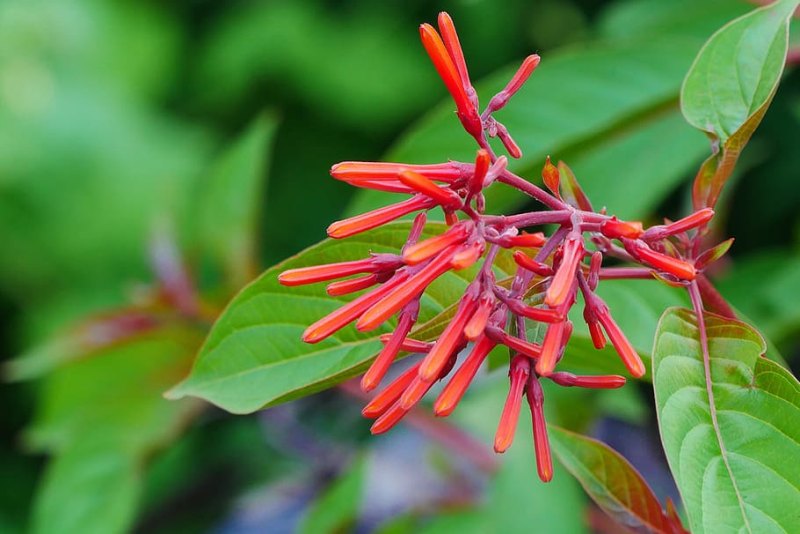
Photo Credit: Wallpaperflare
Trumpet Honeysuckle is a versatile, native, semi-evergreen to deciduous vine featuring showy, trumpet-shaped flowers that bloom from March to June. This native plant is a favorite among hummingbirds, bees, and butterflies, making it an excellent choice for a wildlife-friendly garden. Trumpet Honeysuckle is a low-maintenance option that tolerates various soil types and is resistant to pests and diseases.
Plant type: Vine
USDA hardiness zone: 4 to 9
Duration: Perennial
Foliage: Deciduous to semi-evergreen
Sunlight needs: Full sun to partial shade
Soil preferences: Prefers moist soil. Clay, sandy, loam, slightly acidic, well-drained
Water needs: Medium
Mature size: 10 to 15 feet long
Potential hazards: Non-toxic; no safety hazards
Maintenance: Trim after blooming to maintain its shape and manage growth. Remove any new growth and damaged buds to keep it healthy, and wash off aphids that appear in spring.
2. Cardinal Flower (Lobelia cardinalis)
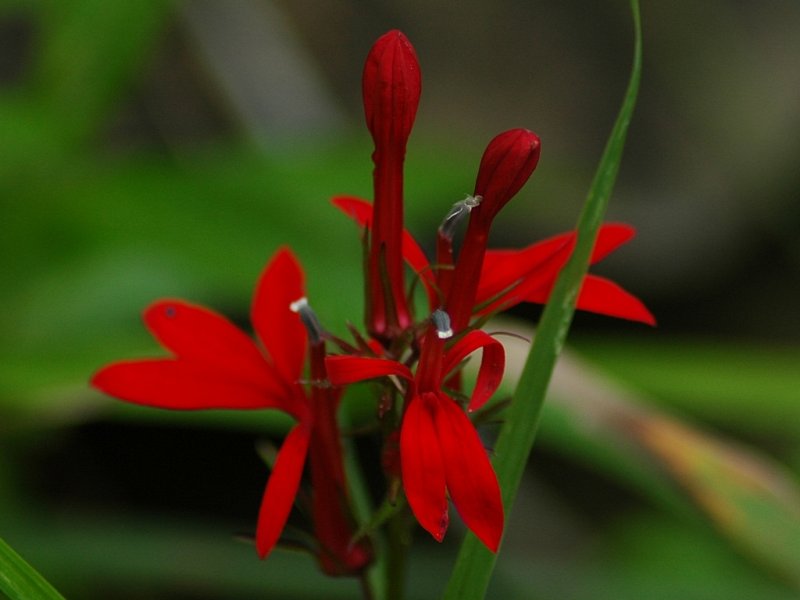
Photo Credit: linnaeus / Wikimedia Commons / CC BY 3.0
Cardinal Flower, a captivating perennial, showcases tall spikes adorned with beautiful red flowers from midsummer to early fall. With its unique long tubular flowers, most insects struggle to access its nectar, making hummingbirds the primary pollinator for this stunning plant. Its common name is inspired by the vivid red robes worn by Roman Catholic cardinals.
Plant type: Flower
USDA hardiness zone: 3 to 9
Duration: Perennial
Sunlight needs: Full sun, partial shade, full shade
Soil preferences: Moist to wet, humus-rich soil. Sandy, loam, clay, limestone-based
Water needs: Medium to high
Mature size: 1 to 6 feet tall
Potential hazards: Toxic to humans and animals if ingested in large quantities.
Maintenance: Keep the soil moist or wet at all times for the plant to thrive.
3. Eastern Redbud (Cercis canadensis)
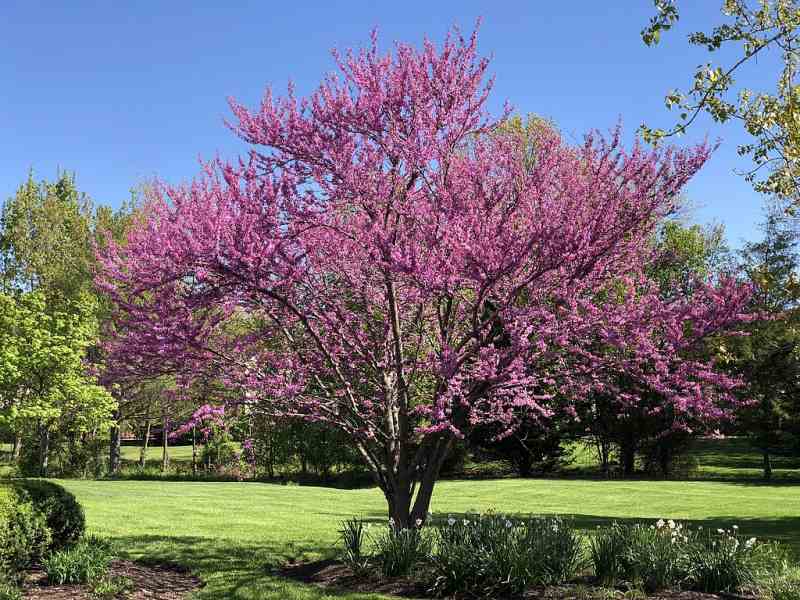
Photo Credit: Famartin / Wikimedia Commons / CC BY-SA 4.0
Eastern Redbud is a small deciduous tree with a short trunk, heart-shaped leaves, and showy pink flowers that bloom in early spring. This native tree attracts pollinators, such as hummingbirds and butterflies, and provides nesting sites for birds. Eastern Redbud is adaptable to various soil types and is relatively low-maintenance.
Plant type: Tree
USDA hardiness zone: 4 to 9
Duration: Perennial
Foliage: Deciduous
Sunlight needs: Full sun or partial shade
Soil preferences: Moist, fertile, well-drained soils
Water needs: Low
Mature size: 15 to 30 feet tall with a 25 to 35 foot spread
Potential hazards: Contains a toxic saponin, but is not typically considered toxic as ingestion generally does not cause harmful effects.
Maintenance: A weekly deep watering is beneficial during prolonged periods of heat and drought. It’s also advisable to fertilize the tree in early spring.
4. Purple Coneflower (Echinacea Moench)
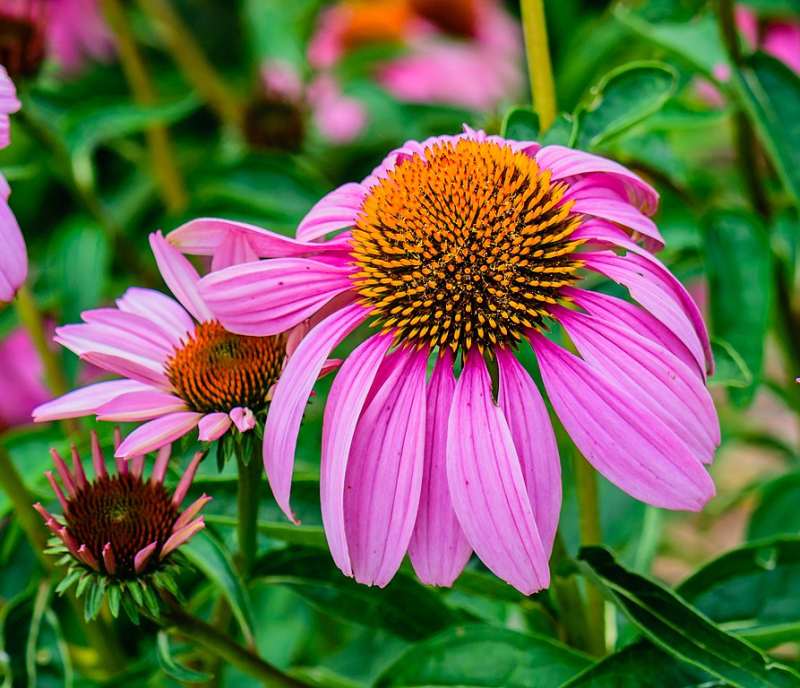
Photo Credit: PumpkinSky / Wikimedia Commons / CC BY-SA 4.0
Purple Coneflower is a perennial wildflower native to the Louisville area. It’s known for its vibrant, daisy-like blooms, and hardy, low-maintenance nature. This popular plant has large, purple-pink petals, which would give a touch of color to your garden. In addition to its striking appearance, this native plant also attracts butterflies, hummingbirds, and native bees.
Plant type: Flower
USDA hardiness zone: 3 to 8
Duration: Perennial
Foliage: Deciduous
Sunlight needs: Full sun to partial shade
Soil preferences: Dry
Water needs: Medium
Mature size: 2 to 5 feet tall
Potential hazards: Non-toxic; no safety hazards
Maintenance: Low
5. Northern Spicebush (Lindera benzoin)
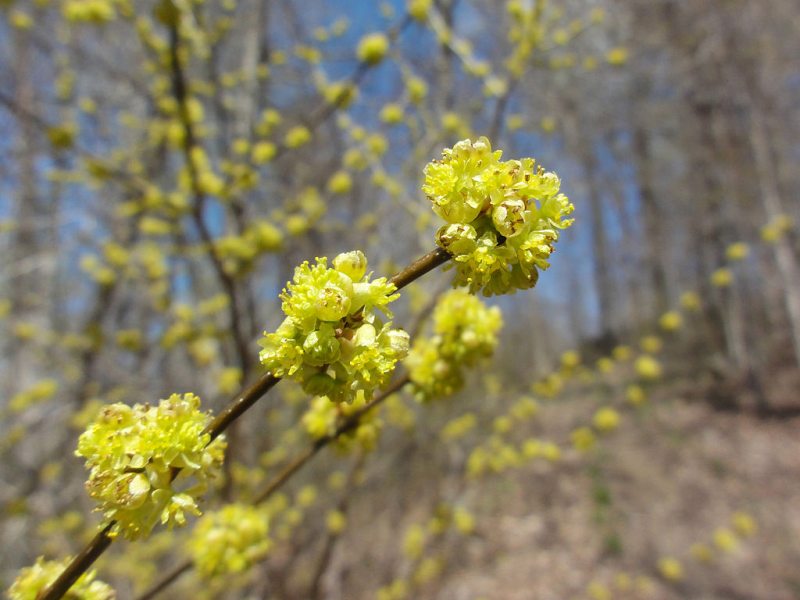
Photo Credit: R. A. Nonenmacher / Wikimedia Commons / CC BY-SA 4.0
Northern Spicebush is a deciduous shrub with fragrant greenish-yellow flowers in early spring and bright golden yellow foliage in the fall. It is adaptable to various soil types and moisture levels.
Moreover, the Eastern Tiger Swallowtail and Spicebush Swallowtail butterflies use this plant as a larval host, providing a crucial habitat for their caterpillars to thrive. A tea can also be made from its leaves and twigs, and its fruit, once dried and powdered, can be used as a spice.
Plant type: Shrub
USDA hardiness zone: 5 to 9
Duration: Perennial
Foliage: Deciduous
Sunlight needs: Full sun to partial shade
Soil preferences: Moist, well-drained soils. Sandy, loamy, limestone-based
Water needs: Medium
Mature size: 8 to 15 feet tall
Potential hazards: Non-toxic; no safety hazards
Maintenance: Keep the soil moist and fertilize it twice a year
6. Swamp Milkweed (Asclepias incarnata)
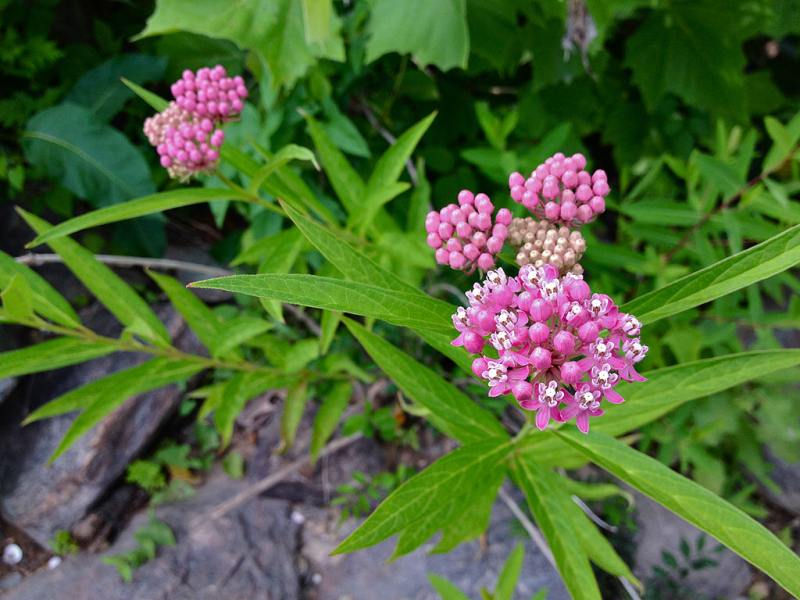
Photo Credit: Fritzflohrreynolds / Wikimedia Commons / CC BY-SA 3.0
Swamp milkweed is a perennial with clusters of rose-purple flowers that bloom from June to October. This native plant is an essential host for queen and monarch butterfly larvae and attracts other pollinators, such as hummingbirds. It is well-suited for rain gardens or areas with moist soil.
Plant type: Flower
USDA hardiness zone: 3 to 6
Duration: Perennial
Sunlight needs: Full sun to partial shade
Soil preferences: Thrives in mucky clay soils. Prefers neutral to slightly acidic soil.
Water needs: High
Mature size: 3 to 5 feet tall
Potential hazards: Poisonous when ingested raw and can be lethal to animals
Maintenance: This native plant performs well in poor soils. It does not need fertilization.
7. Spotted Geranium (Geranium maculatum)
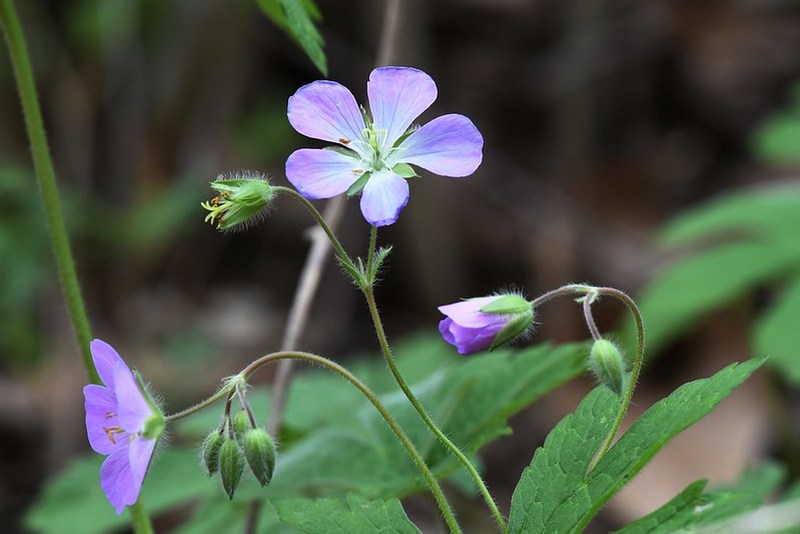
Photo Credit: Andy Reago & Chrissy McClarren / Flickr / CC BY 2.0
Spotted geranium is a woodland perennial with showy, lavender-pink, five-petaled flowers that bloom from March to July. It is a low-maintenance option for a woodland garden, as it tolerates various soil types and moisture levels.
This native plant attracts pollinators, such as hummingbirds, and its seeds appeal to Mourning Doves, Bobwhite Quail, and White-tailed Deer. It can also be used medicinally for diarrhea, inflamed gums, sore throat, thrush, and mouth ulcers.
Plant type: Herbaceous perennial
USDA hardiness zone: 3 to 11
Duration: Perennial
Foliage: Semi-evergreen
Sunlight needs: Full sun or partial shade
Soil preferences: Clay, silt, high organic matter, or sandy soil that’s well-drained, moist, or somewhat wet
Water needs: Medium
Mature size: 1 to 2 feet tall
Potential hazards: Non-toxic; no safety hazards
Maintenance: Low
8. Wild Hydrangea (Hydrangea arborescens)
Wild hydrangea is a deciduous shrub with large, flat-topped clusters of greenish-white flowers that bloom from late spring to late summer. This native plant attracts pollinators and provides a habitat for hummingbirds. Wild hydrangea is a low-maintenance option that tolerates various soil types, making it a versatile choice for Louisville landscapes.
Plant type: Shrub
USDA hardiness zone: 3 to 9
Duration: Perennial
Foliage: Deciduous
Sunlight needs: Partial shade
Soil preferences: Rich, well-drained, moist soil
Water needs: Medium
Mature size: 3 to 6 feet tall
Potential hazards: All parts of the plant are poisonous to humans and animals.
Maintenance: Needs supplemental watering in hot, humid summers
9. Sensitive Fern (Onoclea sensibilis)
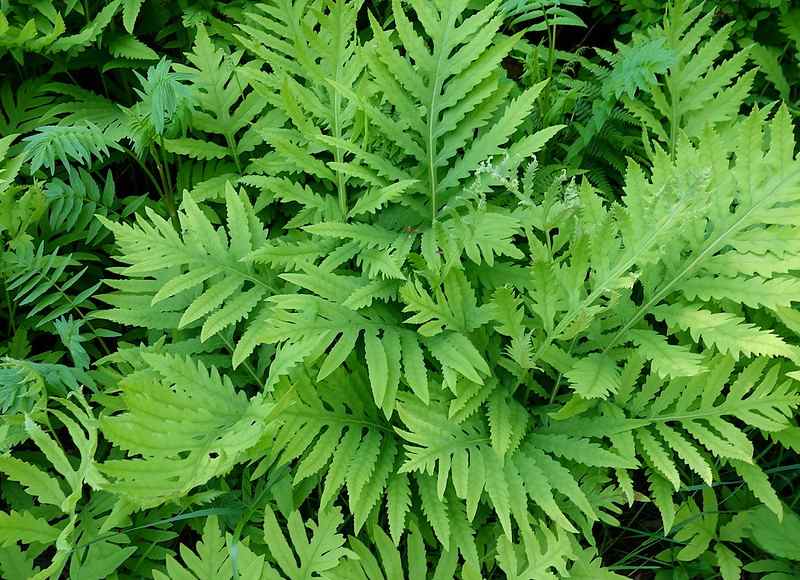
Photo Credit: Under the same moon… / Flickr / CC BY 2.0
Sensitive fern is a hardy, deciduous fern known for its delicate, bright green fronds. It is often found in moist, shady areas near streams or woodlands. It thrives in well-draining, humus-rich soil. Its name is derived from its sensitivity to first frost, as the plant’s fronds tend to wither with the first signs of cold weather.
Plant type: Fern
USDA hardiness zone: 4 to 8
Duration: Perennial
Foliage: Deciduous
Sunlight needs: Partial shade to full shade
Soil preferences: Various loose, acidic, moist to wet soils. Sandy, loamy, limestone-based
Water needs: Medium to High
Mature size: 2 to 4 feet tall
Potential hazards: Can be toxic to humans in ingested in large quantities
Maintenance: Needs consistent moisture to thrive
How to Choose Native Plants for Your Louisville Landscape
When selecting native plants for your Louisville garden, it’s essential to consider the specific needs and conditions of your outdoor space. Follow these steps to assess your garden and choose the right plants:
- Sunlight exposure: Observe your garden at different times of the day to determine which areas receive full sun, partial shade, or full shade. Native plants thrive best when they are grown in conditions that closely resemble their natural habitats.
- Soil type: Test your soil to determine its composition. Knowing the type of soil you have will help you select the best native plants for your garden.
- Drainage and moisture levels: Assess the drainage in your garden and the moisture levels in your soil. This information will help you choose plants that can thrive in your garden’s specific conditions.
Furthermore, it’s best to note that Louisville falls on the border of USDA Hardiness Zones 6 and 7. This zone classification can guide you in selecting plants that can tolerate our local climate. By carefully considering these factors, you can create a thriving, low-maintenance garden filled with Kentucky native plants that enhance the beauty of your landscape.
FAQ About Native Louisville Plants
Native plants offer numerous benefits, including supporting local ecosystems, being adapted to the local climate, and generally requiring less maintenance. They require less water, fertilizers, and pesticides. By incorporating these plants into your garden, you can contribute to the preservation of Derby City’s botanical heritage.
While native plants offer many advantages, they are not inherently better than non-native plants in every situation. The key is to choose plants that are non-invasive and suited to your specific garden conditions and goals. In some cases, mixing native and non-native plants can provide the ideal landscape that fits your preferences.
Native plants typically require less maintenance than non-native species, as they are already adapted to local soil and weather conditions. To care for native plants, provide them with a suitable growing environment, such as the appropriate sunlight exposure and soil type. Water them as needed, especially during their first year of growth, and use organic mulch to help retain moisture and suppress weeds.
Where to Find Native Plants in Louisville
Are you ready to transform your Louisville garden into an oasis of native plants? From vibrant wildflowers and lush ferns to hardy grasses and low-maintenance groundcovers, the local flora offers something for every garden design and aesthetic. To get started, explore these local native plant suppliers listed on the Kentucky Native Plant Society’s website:
- Beargrass Thunder
- Grow Wilder Native Plant Nursery
- Idlewild Butterfly Farm
Native plants are perfect for homeowners that are looking for low-maintenance landscaping ideas for their outdoor space. You should also consider the best grass types in Louisville that would perfectly complement your new native plants.
To keep your native plants looking their best, connect with local lawn care pros for outdoor maintenance services, such as mowing, trimming, and edging. With the help of these pros, your outdoor space can stay green and lush, ensuring that your native plants thrive year-round.
Main Photo Credit: Winchester House, Louisville / w.marsh on Flickr / Wikimedia Commons / CC BY 2.0